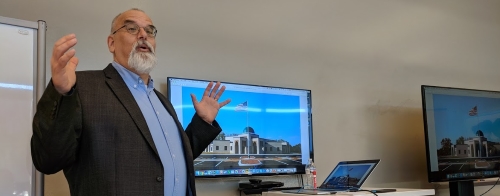
The presentation was titled “How to Talk about God without Starting a Fight” but it could just as well have been called “How to Report on Cat Cults and Snake Handlers.” Veteran religion reporter Bob Smietana was at Upper House on the University of Wisconsin campus and he brought along tales of the unusual stories he has covered over the years.
Smietana is senior writer for Facts and Trends, a publication under the Southern Baptist Convention umbrella. Prior to that he was at Christianity Today, and six years as the Nashville Tennessean‘s religion writer. His recent freelance writing include articles on faith in the Philadelphia Eagles’ locker room, which ran in the Washington Post. He’s also the past president of the Religion News Association.
Smietana lives in Nashville, and offered insights into the unique religious character of the region, which he has been able to report on. That includes a former Baptist megachurch which is now home to the city’s largest Roman Catholic church, a Hispanic congregation. He also discussed the inside story of how he reported on a local cat cult (the headline was “Apocalypse Meow”) and a congregation of snake handlers (including a video clip).
He clearly enjoys reporting on religion where the stories can sometimes be just plain weird (a Jehovah’s Witness in a witness protection program), dangerous (snake handling), or even harmful (corrupt religious leaders). Smietana has done his share of investigative stories on church corruption and offered suggestions on where to go to dig up financial information that people would like to keep hidden. “Unfortunately it’s easy to steal money from a church,” he said.
Religion reporting can also tell some amazing stories about sacrifice and dedication. After Smietana reviewed the bitter 5-year fight to oppose construction of a mosque in Murfreesboro, Tennessee, he told about an Episcopal Church in nearby Smyrna, Tennessee, that was saved from closing by a congregation of Burmese refugee immigrants.
The church had dwindled down to a couple dozen people and had a million dollar mortgage. An interim pastor arrived with the assignment to close it down. But then the refugees arrived, who had come to Christian faith many years before through an Anglican missionary, and the church was revived. “This is going on in America too,” he said, adding that the story had been made into a movie.
Reporting the tensions in Murfreesboro reflected the lessons learned in talking to people he disagreed with, who were opposing the construction project. “People do all kinds of fascinating things that you would never know if you’re fighting with them on Twitter,” he said. “If I told them, ‘No, you’re wrong,’ I never would have found out these things.” He concluded, “I don’t have to agree with them to understand them.”
Three questions that Smietana employs in his interviews, to make sure he understands what people are talking about, are: “Tell me what you mean by that,” “How do you know that?” and “How did you end up here?”
The religious character of America is changing, and Smietana discussed the challenges of reporting that dimension as well, including the emergence of a growing demographic of people called the “nones.” There’s much to discover on the religion beat.
“You can find a religion story anywhere,” he said. “There are a dozen stories in your church.”

